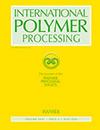Investigation of mechanical and tribological performance of wood dust reinforced epoxy composite under dry, wet and heated contact condition
IF 1.9
4区 工程技术
Q4 ENGINEERING, CHEMICAL
引用次数: 0
Abstract
Abstract Natural fibers have received a lot of attention from academia as well as industry in the context of sustainable materials. Since they are more environmentally friendly than traditional synthetic materials, their physico-mechanical and frictional properties such as porosity, moisture absorption, high strength, modulus, toughness, and wear resistivity make them appropriate for a variety of industrialized applications where issues involving a significant quantity of dumping must be taken into account. The paper introduces an attempt to use epoxy-based composites reinforced with wood dust for various applications. The composites are prepared with various wood filler stacks (0, 2.5, 5, 7.5, 10, and 12.5 wt%) embedded with epoxy resin and subjected to tensile and flexural testing. The highest ultimate tensile strength achieved at 7.5 wt% wood dust support is 22 MPa, whereas the highest flexural modulus is 0.48 GPa at 12.5 wt% composites. The composite’s wear properties is examined under dry, wet, and heated contact conditions using a pin-on-disk (POD) machine. In dry condition, coefficient of friction (COF) varies from 0.10 to 0.38 whereas, in wet condition, the value of COF decreased by 70–83 %. In heated state, the COF is increased by up to 15 % when varying the temperature from 40 °C to 80 °C. The composite exhibits better wear behavior in the lower filler support than in the higher filler support due to the sturdy connection between the matrix and filler. On the other hand, the wet state’s tribological performance is superior to the dry and heated states. During surface morphology analysis, it is found that various voids, crack formation, wear debris, and thin transfer layer formation take place on the composite.木屑增强环氧树脂复合材料在干燥、潮湿和加热接触条件下的机械和摩擦学性能研究
摘要 在可持续材料方面,天然纤维受到学术界和工业界的广泛关注。由于天然纤维比传统合成材料更环保,而且具有多孔性、吸湿性、高强度、高模量、高韧性和耐磨性等物理机械和摩擦特性,因此适用于各种必须考虑大量倾倒问题的工业化应用。本文介绍了在各种应用中使用木屑增强环氧基复合材料的尝试。这些复合材料采用不同的木质填料堆(0、2.5、5、7.5、10 和 12.5 wt%),并嵌入环氧树脂,然后进行拉伸和弯曲测试。木屑含量为 7.5 wt%的复合材料的最高极限拉伸强度为 22 兆帕,而木屑含量为 12.5 wt%的复合材料的最高弯曲模量为 0.48 GPa。在干燥、潮湿和加热接触条件下,使用针盘(POD)机检测了复合材料的磨损特性。在干燥状态下,摩擦系数(COF)从 0.10 到 0.38 不等,而在潮湿状态下,COF 值下降了 70-83%。在加热状态下,当温度从 40 °C 变化到 80 °C 时,摩擦系数最多可增加 15%。由于基体和填料之间的牢固连接,复合材料在低填料支撑下的磨损性能优于高填料支撑下的磨损性能。另一方面,湿态的摩擦学性能优于干态和加热态。在进行表面形态分析时发现,复合材料上出现了各种空隙、裂纹、磨损碎屑和薄转移层。
本文章由计算机程序翻译,如有差异,请以英文原文为准。
求助全文
约1分钟内获得全文
求助全文
来源期刊

International Polymer Processing
工程技术-高分子科学
CiteScore
2.20
自引率
7.70%
发文量
62
审稿时长
6 months
期刊介绍:
International Polymer Processing offers original research contributions, invited review papers and recent technological developments in processing thermoplastics, thermosets, elastomers and fibers as well as polymer reaction engineering. For more than 25 years International Polymer Processing, the journal of the Polymer Processing Society, provides strictly peer-reviewed, high-quality articles and rapid communications from the leading experts around the world.
 求助内容:
求助内容: 应助结果提醒方式:
应助结果提醒方式:


